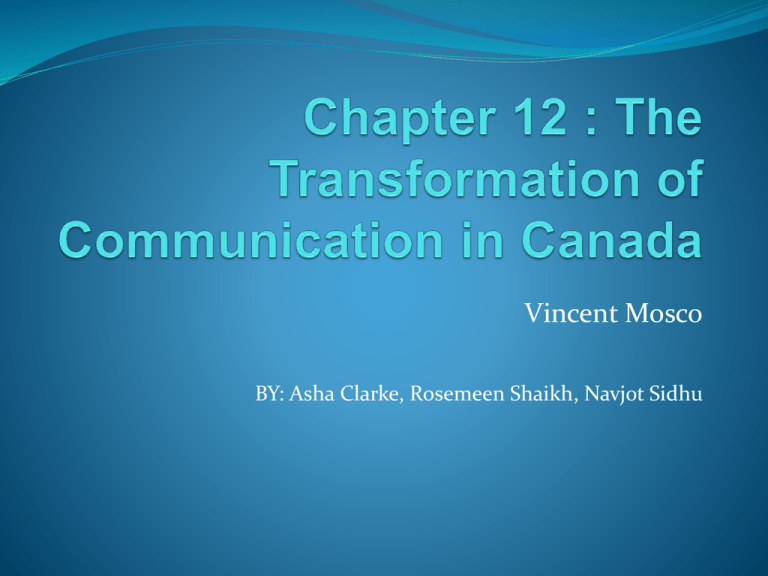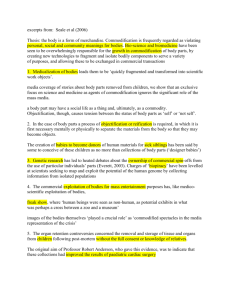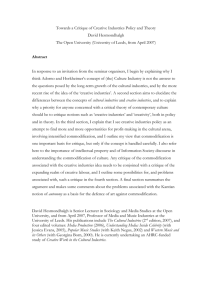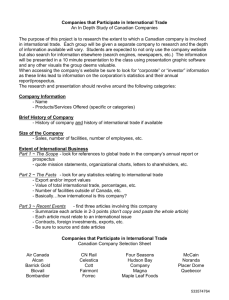The Transformation of Communication in Canada
advertisement

Vincent Mosco BY: Asha Clarke, Rosemeen Shaikh, Navjot Sidhu Introduction: Millennium Mergers New Millennium = Transformation in Communication Industry Began in 2000 with AOL-Time Warner take over Brought together world’s largest Internet service provider and world’s largest holder of intellectual property Canadian Media Mergers Canadian media companies followed in the steps of U.S Bell Canada Enterprises (BCE) CanWest Corporation Quebecor Rogers Communication Political Economy Approach What can a political economy approach contribute to our understanding of these developments in communications? Chapter 12 considers: The process of digitization and commodification underlying new media concentration trend The consequences for Canada for putting in place a regional and global communication regime Political Economy Approach Political economy helps expand our understanding of expansion of market power in the communications arena Media concentration = advanced by powerful processes, but are not subject to singular forces DIGITIZATION Provides gains in transmission speed and flexibility over electronic communication that relied on analog techniques Allows for one language to govern over all electronic media Common universal language = digitization as attractive Negroponte (1995) new digital technologies are creating a fundamentally new world that we must accommodate to End of the world of atoms (rough, limited, materiality) beginning of digital world ( transcends spatial, temporal and material constraints) Idea that there is no alternative, that no social or natural action can stop the emergence of the digital world = digital age cannot be stopped Digitization is aligned with the discourse by Fukuyama about the end of history, end of geography, and the end of politics COMMODIFICATION Miege (1989) flow-type communication systems Commodification Based on inflexible system of delivering a batch of broadcast channels into the home Fordist model = generic programming to mass audience Refinement of Commodification of communication through digitization Which allows for commodity to be measured, monitored and packaged in a specific manner Commodification of Labour Movement away from mechanical labour to electronic systems Elimination of jobs in the printing industry CONFLICTS Digitization is not a flawless technical process and is subject to problems that slow it down Commodification is challenged by organizations defending both private sphere and public sphere Right to privacy Right to communicate openly and in a democratic fashion Marxist perspective The social impact of commodification = alienation and commodity fetishism Commodity fetishism = state of social relations that arise in a complex capitalist market structure in which the social relationships place commodities at the centre VIDEO CLIP http://www.youtube.com/watch?v=iu0ztxdsFis Toward an Integrated Electronic Information and Entertainment Services Arena Digitization has allowed for one common language to be developed across the communication industry and so there are no longer distinct barriers dividing these industries which include: 1) Print 2) Broadcasting and Telecommunications 3) Information Technology or Computer Data LEGAL REGIMES Print Publishing industry Limited government involvement Local, typically family owned Broadcasting and telecommunication Canada/United States/Europe all placed higher restrictions on radio, television, telephone systems in order to accomplish national objectives such as national identity and a national market Information Technology & Computer Data When this sector took off it was not seen as holding any public interest or public service responsibilities, no system of subsidized pricing to those who need it, no commitment to universality of access, and no expectation that national firms would shortly be on the way to multinational control CONVERGENCE The coming together of all communication sectors around regimes that are in place for the information technology and computer data sectors The Concentration of Power in the Communication Business 1) BCE – CTV – Thomson (Globe & Mail) 2) Rogers – MacLean Hunter 3) CanWest Global – Hollinger 4) Quebecor – Sun Media – Groupe Videotron (French language & tabloid media) The Concentration of Power in the Communication Business Canada has allowed companies to build structures that integrate across monopoly and competitive markets and across production and distribution Example, Bell Canada Enterprise Toward a Regional and Transnational Communication Order Political Globalization and Global Context Free Trade Agreement, North American Free Trade Agreement World Trade Organization Regional and Global Integration Example 1999 Bell Canada permitted the U.S. telephone company Ameritech to acquire a 20% stake in it Rogers Communication deal with Microsoft to sell a minority stake to the U.S. firm, whereby Microsoft would use Canada’s largest cable television provider to develop high speed Internet access services 1999, Rogers sold a $1 billon stake in its mobile telephone company to AT&T and British Telecom (AT&T used the WTO to challenge Canadian dominance of Bell Canada) FTA AND NAFTA Liberalized trade in this sector under both was permitted by a notwithstanding clause that allowed retaliation against cultural protectionism through measures in other industries, by general agreements on restricting government activity, and by liberalizing trade in sectors converging with the cultural industries FTA AND NAFTA Treaty provisions also require “national treatment” to each others companies Treaty provisions also place restrictions on the ability of governments to establish new government or public institutions to provide services in competition with private businesses Global Pressures The WTO has had more of an active role than regional trade agreements in applying pressures to expand transnational control over Canadian communications IDEOLOGICAL SHIFT Although the Canadian state has traditionally attempted to create protectionist policies in the communications industry we are now beginning to see a shift Protectionist Policies within the Culture and Communications sectors have readily become a part of the general processes of government funding cutbacks Although attempts have been made to preserve culture through media it is difficult to dissolve close ties with U.S and global markets Contradictions & Opposition Recap: Neoliberalism = retreat of the state/government from all areas of social life; private sector best provides these functions Neoliberalism is contradictory to the operation of the communication arena, since it clearly demonstrates that its ideals are not easy to accomplish; governments are needed to regulate & standardize Contradictions & Opposition Technical concerns standardization, who sets standards? Competitors reluctant to cooperate since they would have to share info, which may be valuable, private, and central to their own success Contradictions & Opposition ITU (International Telecommunications Union): global body made up of government organizations and run on a one nation, one-vote basis to establish global standards for new technology Setting up public national or international regulatory authorities Critical to capitalist expansion How can access be expanded for technology to build markets? How is it ensured that some measure of privacy will create consumer confidence in technology? Government brought in to regulate by capitalists; governments succeeded; opened private arena to public, who used opportunity to fight for public broadcasting Contradictions & Opposition Fight for personal privacy part of a wider struggle against expanding commodity Conflict between need to build consumer confidence to turn internet into universal market tool & the need to commodify whatever moves over Internet, including personal identity Conflict deepened by technology industries opposition to state intervention Privatization of public space and centrality of culture & communication Struggle of public space as global business directed to branding of physical & cultural space; Americanization? Contradictions & Opposition Shift from productivist emphasis on international division of labour to concern for consumption & cultural reception Expansion of consumer markets & growth of popular culture Use of communication/info technology for opposition & resistance building global resistance movements Major opposition movements based on building global solidarity & strategy through use of communication systems Strategy takes many forms: Direct attacks on communication systems of transnational companies Use of cyberspace to advance politics of democratic communication Global communication can result in open areas of attack (ie. 9/11) Conclusions Several processes of transformation taking place in Canadian communication Digitization and Commodification are providing opportunities for capital to turn content, audiences and labour of the communication industries into marketable commodities Leading to the amalgamation of multiple industries such as the printing, broadcasting, telecommunications and IT sectors Media Concentration: media ownership within Canada where only 4 –5 groups hold power and manage the communication industry marginalization of others However, each transformation processes contain problems; ranging from glitches to outright challenges National preferences are promoted by companies, who are threatened by transnational integration led to new social movements against WTO QUESTIONS How are the forces of globalization through international capital and new globalized communication networks acting on the entity Canada and how are they changing it into a North America without borders? Is Canadian identity/national culture threatened through mergers and privatization of communication? CLASS EXERCISE Exercise will consist of class divided in to two sides: FOR & AGAINST Statement provided to class; each side gets 2 minutes to discuss with group Each side will get 1-2 minutes to present arguments Debate! Side w/ best arguments win prize! [Add quote] CLASS EXERCISE “The convergence of accelerating communication & transportation networks & expanding neoliberalism poses danger of an explosive combination.” (Pg. 306) “Like a force of nature, the digital age cannot be denied or stopped.” (Pg. 290) “It is quite fair to say that in some areas the Canadian government blazed new ground, as in May 1999 when it fully supported the decision of its chief communication regulatory authority to formally rule against regulation of the Internet.” (Pg. 299) THE END






